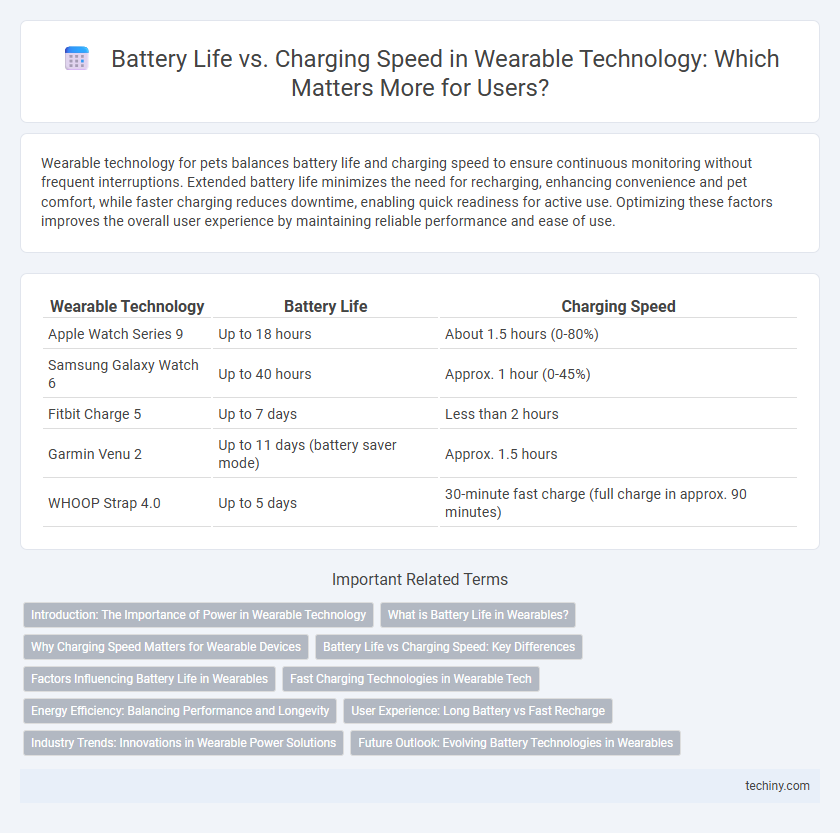Wearable technology for pets balances battery life and charging speed to ensure continuous monitoring without frequent interruptions. Extended battery life minimizes the need for recharging, enhancing convenience and pet comfort, while faster charging reduces downtime, enabling quick readiness for active use. Optimizing these factors improves the overall user experience by maintaining reliable performance and ease of use.
Table of Comparison
| Wearable Technology | Battery Life | Charging Speed |
|---|---|---|
| Apple Watch Series 9 | Up to 18 hours | About 1.5 hours (0-80%) |
| Samsung Galaxy Watch 6 | Up to 40 hours | Approx. 1 hour (0-45%) |
| Fitbit Charge 5 | Up to 7 days | Less than 2 hours |
| Garmin Venu 2 | Up to 11 days (battery saver mode) | Approx. 1.5 hours |
| WHOOP Strap 4.0 | Up to 5 days | 30-minute fast charge (full charge in approx. 90 minutes) |
Introduction: The Importance of Power in Wearable Technology
Battery life and charging speed are critical factors defining user experience in wearable technology, influencing device usability and convenience. Efficient power management extends operational time, reducing the frequency of recharges while fast charging technology minimizes downtime. Optimizing these aspects ensures continuous function for health monitoring, fitness tracking, and communication.
What is Battery Life in Wearables?
Battery life in wearables refers to the duration a device can operate on a single charge, typically measured in hours or days depending on usage and device type. Key factors influencing battery life include sensor activity, display type, wireless connectivity, and power management technologies. Optimizing battery life ensures continuous health tracking and user convenience without frequent recharging interruptions.
Why Charging Speed Matters for Wearable Devices
Charging speed significantly impacts wearable devices by reducing downtime and ensuring continuous usage, crucial for health trackers and smartwatches that monitor vital signs in real-time. Faster charging capabilities enhance user convenience, allowing users to quickly replenish battery levels during short breaks or daily routines. Optimizing charging speed helps maintain device reliability and user engagement, especially in time-sensitive situations where prolonged battery life alone may not suffice.
Battery Life vs Charging Speed: Key Differences
Battery life indicates how long a wearable device operates on a single charge, often ranging from 1 to 7 days depending on usage and power management. Charging speed measures the time required to replenish the battery, with fast-charging technologies reducing downtime to under an hour for many smartwatches and fitness trackers. Balancing extended battery life with rapid charging involves trade-offs in battery capacity, device size, and thermal management to optimize user convenience and performance.
Factors Influencing Battery Life in Wearables
Battery life in wearable technology is primarily influenced by factors such as battery capacity, power consumption of sensors, display type, and connectivity options like Bluetooth or Wi-Fi. Efficient energy management, including optimized software algorithms and low-power hardware components, significantly extends usage duration between charges. Environmental conditions and user habits, such as screen brightness and frequency of notifications, also impact overall battery performance in wearables.
Fast Charging Technologies in Wearable Tech
Fast charging technologies in wearable technology significantly enhance battery life management by reducing downtime and enabling prolonged device usage. Innovations such as Qualcomm Quick Charge and USB Power Delivery optimize energy transfer rates, allowing wearables to reach full charge in under an hour without compromising battery health. Efficient power management systems integrate with these fast charging protocols to balance rapid energy replenishment and overall battery longevity.
Energy Efficiency: Balancing Performance and Longevity
Wearable technology demands a careful balance between battery life and charging speed to optimize energy efficiency, ensuring devices maintain high performance while maximizing longevity. Advanced battery management systems and adaptive charging algorithms dynamically adjust power usage to extend operational time without compromising fast recharge capabilities. Prioritizing energy-efficient components and power-saving modes further enhances overall device sustainability in compact wearable designs.
User Experience: Long Battery vs Fast Recharge
Wearable technology balances battery life and charging speed to enhance user experience, with extended battery life reducing frequent interruptions and ensuring continuous usage throughout the day. Fast recharge capabilities minimize downtime, allowing users to quickly power up devices during short breaks. Prioritizing either long-lasting battery capacity or rapid charging depends on individual needs, such as all-day activity tracking versus quick readiness for on-the-go use.
Industry Trends: Innovations in Wearable Power Solutions
Emerging industry trends in wearable technology highlight innovations such as ultra-fast charging batteries and energy-dense solid-state cells, significantly enhancing battery life without compromising device size. Advanced materials like graphene and silicon anodes enable faster energy transfer, reducing charging times to minutes while supporting longer usage periods. Integration of solar-harvesting fabrics and kinetic energy converters further extends battery autonomy, reflecting a shift towards sustainable and efficient wearable power solutions.
Future Outlook: Evolving Battery Technologies in Wearables
Advancements in solid-state batteries and fast-charging graphene supercapacitors are set to revolutionize battery life and charging speed in wearable technology. Emerging materials like silicon anodes and flexible polymer electrolytes enhance energy density while maintaining lightweight, flexible designs crucial for wearables. These innovations promise extended usage periods and rapid recharge capabilities, driving the next generation of efficient and user-friendly wearable devices.
Battery Life vs Charging Speed Infographic

 techiny.com
techiny.com